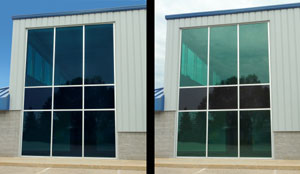
Pleotint window on left darkened to neutral-gray tint as heat load increased. On the right, the window has returned to clearest state as direct sunlight decreased. Credit: PPG Industries
I’ve written several times the past about electrical (e.g., Sage) and passive (e.g., RavenBrick) dynamic (chromic) window systems and how some heavy hitters, such as Saint-Gobain and GE, are making big investments in these energy-saving technologies. Not to be outdone, PPG announced yesterday that it is jumping on this bandwagon and has inked an agreement to jointly market a triple-layer window that employs an auto-adjusting film developed by Pleotint. PPG/Pleotint say they are marketing this as a Sunlight Responsive Thermochromic technology that will be paired with other PPG products such as its Solarban low-e glass.
As with most of these technologies, the idea is to control solar heat gain and losses, and therefore reduce energy costs in commercial and residential buildings. Solarban is already designed to block solar heat but allow a substantial amount of visible light to pass. Pleotint’s SRT film is designed to cut both UV and IR transmission. When teamed up with something like Solarban, Pleotint says that IR levels are cut to essentially zero and UV to less than 5 percent. Visible light is cut anywhere between 45-90 percent, depending on the sunlight intensity, which isn’t as drastic as it may sound because the greatest decrease in visibility occurs when the level of light is most intense. Pleotint says on its website, the “SRT film never eliminates visibility – building occupants always see outside.”
The active component of Pleotint’s film is what the DOE Information Bridge document describes as a “ligand exchange thermochromic system … The thermochromic systems of this research have a net increase in absorbed light energy as the temperature is increased and a net decrease in absorbed light energy as the temperature is decreased for temperatures within the active range of the system. The active temperature range of the system is determined by the thermodynamic properties of the LETC reactions. For many of our preferred applications the active temperature range includes 0 to 85°C.” The LETC material is extruded in a poly(vinyl butyral) film.
The company was started by Harlan Byker, who earlier in his career worked at Battelle Memorial Institute and later had his electrochromic mirror system become the basis for Gentex, a company that developed self-adjusting mirrors for the transportation market. In 2010, DOE awarded Pleotint $805,000 to develop a system for further developing the extrusion system for making the film and testing the results. DOE mentions in a recent quarterly report, “Windows were installed at the Iowa [Energy Resource Station] for side by side comparison of thermochromic windows versus the fixed tint windows. Preliminary data shows 6-7% total energy savings so far.” The Lawrence Berkeley National Lab and others are still analyzing the results.
In a story with Rapid Growth Media in mid-2010, Byker estimated that he expected window systems that incorporated his SRT film would have a seven- to 10-year payback period. In this story, he predicted – perhaps with someone like PPG in mind – that, “When we get to higher volumes and our costs drop, the payback could go to 5 years or less.”
Both electrochromic and thermochromic windows have their cheerleaders and detractors. The knock against electrochromic applications is the added costs associated with wiring, controls, etc. The criticism against thermochromics is that they have to greater or lesser extent some temperature dependency, i.e., the phase change occurs when some of the light is converted into heat. John Van Dine, founder of Sage, sounds like he had Pleotint in mind when he said in a recent interview with Forbes, “Thermochromic responds to temperature conditions. It could be a cold day outside, and you’re not getting any transition, but you have this direct glare. You cannot achieve the energy savings possible without having direct user control over what the glass is doing.” I suspect the weakness Van Dine emphasizes can be significantly lessened if the thermochromic film is on an interior pane of a multipaned system, which is the design PPG has in mind.
Makers of both electrochromic and thermochromic systems have their eye on gaining adoption by reducing costs and payback times. Right now, customers of the former have to pay extra for the convenience of an adjustable system, but there seems to demand from architects, building developers and consumers for both options to coexist in the marketplace, so it may be too soon to predict if either of these approaches will end up dominating the other.
